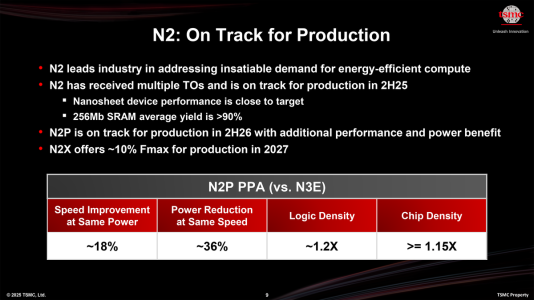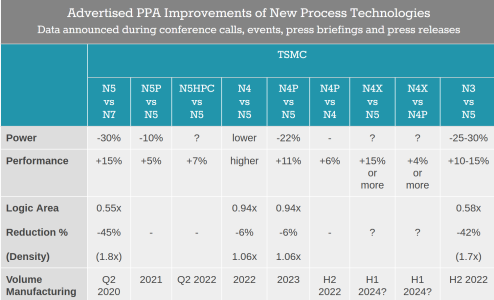Apparently there is also a "stretch goal", which I infer to be higher than 7 GHz.
Why are we entertaining a clown?
Apparently there is also a "stretch goal", which I infer to be higher than 7 GHz.
I will add that the ~40% for Zen5 was true for pure heavy AVX-512 only, but it had some truth to it.
And if we extrapolate from N48 with 0.858x of target then Zen 6 would reach 6008 MHz. A most curious proportionality. It's almost like whoever is making up targets is doing the same math...View attachment 127048
This was the target gfxclk for Navi48 about 1 year before launch. They missed by 490 MHz.
I have no doubt their target for Zen6 is 7GHz, the only question is how close they can get to that target.
View attachment 127048
This was the target gfxclk for Navi48 about 1 year before launch. They missed by 490 MHz.
I have no doubt their target for Zen6 is 7GHz, the only question is how close they can get to that target.
The PS3 emulator got a 30% improvement from avx-512.Where did you get 40% PPC for AVX-512 workloads from? Was there mentioned somewhere officially? Or are you deriving that from your own workloads?
Why are we entertaining a clown?
Primegrid compared to a 7950x vs a 9950x and a 9654 64 core vs a 7742 64 core. My only Zen 3 64 core was a 7763 ES and it only ran at 2.3 ghz/Where did you get 40% PPC for AVX-512 workloads from? Was there mentioned somewhere officially? Or are you deriving that from your own workloads?
While it is POSSIBLE that the new IOD will result in no improvement in latency, with the faster memory and new IOD, why wouldn't you expect a lower latency?You're not getting lower latency.
Lower power? yeah.
Very quickly.Each nanosecond is 6.5 clocks at 6.5 GHz CPU. So shaving off a few nanoseconds can add up.
It's fun to try to make 1+1=3, but I agree, we all tend to do stack ups in a very unreasonable way ..... resulting in launch day depressionFor once, I pray that other forum members can contain themselves from hyping up Zen 6. Let's have a serene launch this time around.
I would encourage those same members to hype up Nova Lake if they want
I was wondering if this could help latency?ES samples are out in the wild and interesting part about the two memory controllers in Zen6
I think the core will provide a small increase, but in general, I agree with where your thoughts are on this.It's not just the overall performance increase, but where it is going to come from.
- from core itself, probably close to 0%
- from bigger L3 slightly lower memory latency - ~5%
- from clock speed 10+%
@adroc_thurston seemed to indicate that total 1T for Zen6 would be +10% * +10-15% = +21-26.5%, I forget which of those was IPC and which of those was clocks but it doesn't seem like they'd hit 7 GHz in any case. MT will be different because of the expansion to 24c on the desktop and unknown all-core boost targets.I have no doubt their target for Zen6 is 7GHz, the only question is how close they can get to that target.
A 12 core X3D alone in one chiplet is enough to upgrade IMO, the rest is just cherry on top. Biggest problem with 8 core X3D is shader compilation ie its not fast enough. A 12 core N2P X3D is a tough one to beat, Q4 2026/early 2027 will be most interesting since Alder Lake.@adroc_thurston seemed to indicate that total 1T for Zen6 would be +10% * +10-15% = +21-26.5%, I forget which of those was IPC and which of those was clocks but it doesn't seem like they'd hit 7 GHz in any case. MT will be different because of the expansion to 24c on the desktop and unknown all-core boost targets.
Well if we get 502 I doubt we will get to page 500 🤣We will have to wait until Page 500 for the real answer.
In the meantime, I don't think we will have any trouble filling pages 192-499 with speculation.
What is CBT?No, AMD just likes doing CBT with their physical design engineers. Remember Navi3x had nearly double the frequency target from Navi1x with just a single node shrink.
What is CBT?
It's like being an engineer Penance Isn't itCock & Ball Torture
It isI hope that is not what @Kepler_L2 was referring to...
That was N4 to N3B, Zen6 is N4P to N2P, plus there is plenty of power headroom for ST if they need it.
It is
That was N4 to N3B, Zen6 is N4P to N2P, plus there is plenty of power headroom for ST if they need it.
The price you pay for minimal IPC gains. This is why @gdansk is right while increasing clock is the easiest way to increase performance of a core it comes at the cost of power consumption.

from TSMC public info we have N5->N3E 18%PPW and N5->N4P 11% PPW that would mean N4P->N3E is 6% better and N3E->N2P is 18%It is
That was N4 to N3B, Zen6 is N4P to N2P, plus there is plenty of power headroom for ST if they need it.




but i want a 7GHz core at 35 wattsThere is no dream story in this world


